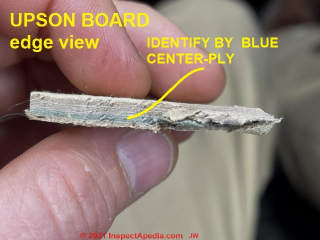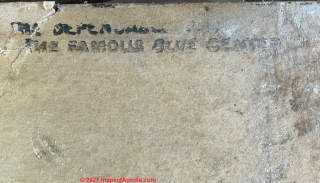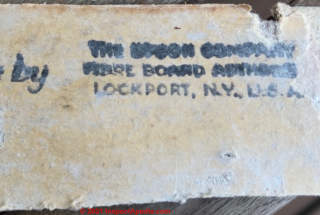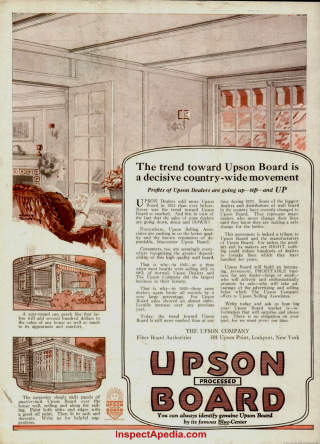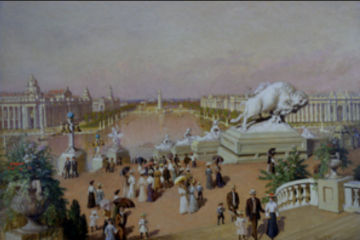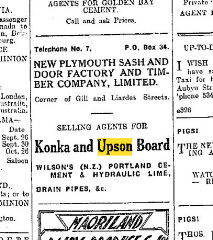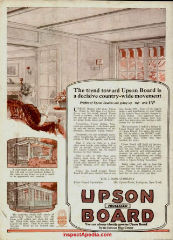 Upson Board
Upson Board
History, properties, & identification key
- POST a QUESTION or COMMENT about Upson board, identification, ingredients, uses, history
This article describes Upson Board, a medium density fiberboard used for building ceilings & walls as well as as a base for paintings and in a variety of other applications. We include a brief history of Upson Board and its inventor and of the company.
Page top illustration: Upson Board advertisement in an issue of The Rotarian from 1923.
InspectAPedia tolerates no conflicts of interest. We have no relationship with advertisers, products, or services discussed at this website.
- Daniel Friedman, Publisher/Editor/Author - See WHO ARE WE?
Upson Board History, Identification, Research
 Upson Board, a medium-density fiberboard made from recycled wood fibers, embossed its marking into the board itself, and a "Blue Center" (illustrated below thanks to one of our readers) runs through every piece of the board.
Upson Board, a medium-density fiberboard made from recycled wood fibers, embossed its marking into the board itself, and a "Blue Center" (illustrated below thanks to one of our readers) runs through every piece of the board.
Examine a cross section of the board for this characteristic blue material. In our photo below you can see the characteristic blue layer in Upson Board.
Upson Board was another laminated fiberboard with one textured side, similar in appearance to Beaver Board. The primary difference was that the back of Upson Board was not stamped with the brand name. Instead, its center layer was dyed blue, making it readily identifiable.
Three widths (32, 48, and 64 inches) and seven lengths were available. In 1920, the manufacturer patented the Upson Self-Clinching Fastener, a five-pronged steel fastener. These were nailed to studs and the fiberboard panels were pressed onto the prongs, which held them in place.
For several decades, medium-density fiberboards remained popular even as their manufacturing processes and ingredients changed. In 1928, CertainTeed Corp. bought Beaver Board Co. and continued to produce Beaver Board under that trade name until the early 1940s.
Upson Co. used the name briefly after buying the Beaver Board factory from CertainTeed in 1955. They continued to make Upson Board, Beaver Universal Fiberboard, and Beaver Fiberboard.
The original Upson Co. closed in 1984. (Wilson et al 2007)
Below: photo of an edge-view of Upson Board found in a New Zealand home built in 1927 and marked with stampings
Upson Board Company, Lockport, NY, USA - courtesy of an InspectApedia reader.
Upson Board was another laminated fiberboard with one textured side, similar in appearance to Beaver Board. The primary difference was that the back of Upson Board was not stamped with the brand name. Instead, its center layer was dyed blue, making it readily identifiable.
Three widths (32, 48, and 64 inches) and seven lengths were available. In 1920, the manufacturer patented the Upson Self-Clinching Fastener, a five-pronged steel fastener. These were nailed to studs and the fiberboard panels were pressed onto the prongs, which held them in place.
For several decades, medium-density fiberboards remained popular even as their manufacturing processes and ingredients changed.
In 1928, CertainTeed Corp. bought Beaver Board Co. and continued to produce Beaver Board under that trade name until the early 1940s. Upson Co. used the name briefly after buying the Beaver Board factory from CertainTeed in 1955. They continued to make Upson Board, Beaver Universal Fiberboard, and Beaver Fiberboard.
The original Upson Co. closed in 1984. - (Wilson-Snodgrass 2007)
Synonyms for Upson board include Upsonboard, Niagara Fiberboard, and Upsonite.
The American Lumberman, February 4, 1922, described a "New Development in Wallboard":
Wallboard is being recommended and used more and more by carpenters and contractors for interiors of homes, hotels, etc., because it is easier to handle and apply than plaster, and reduces painting costs. A new development in the wall board field is announced by the Upson Co., of Lockport, N.Y., fiber board specialist, and it is now possible to obtain wallboard with a "pebbled" surface resembling the surface of mats used for mounting photographs. This new product is known as "Super Surface Upson Board," and is shown in the accompanying illustration.
This unique wall board is the particular pride of the Upson Co., according to a statement recently made by Charles A. Upton, president, who says: "It has been our object ever since the organization of the company to make our product as nearly perfect as possible in two general ways - constructionally and artistically.
From a constructional standpoint our goal has been nearly reached for some time. But the very hardness and excellence of our board made the problem of making an artistic and permanent "pebbling" more difficult than it would on a soft, spongy wall board. The introduction of the new pebbling we believe to be the most important step taken in the direction of wall board beauty since the perfection of plain wall board."
The New board possesses the further advantage of having the reverse side perfectly smooth and lumpless (the regular surface used on all Upson board before pebbling was introduced). The board can be reversed and this side used for the wall surface instead of the pebbled surface, in case a smooth or enameled surface is desired Both of these surfaces take paint remarkably well, and can be tinted to suit the user.
The pebbled surface is used for the interiors of living rooms, dining rooms etc., and the smooth side is well adapted for kitchens or bathrooms. The introduction of this latest Upson innovation follows right on the heels of the Upson Self-Clinching fastener recently put on the market. It shows the progressive spirit of this organization, which claims to have been the originator of many improvements introduced in the wall board industry during the last ten years. (American Lumberman, 1922)
Upsonboard was also widely-used as a base for oil paintings (e.g. Key, John Ross 1904 cited below), though without an authentication of the actual board material, on occasion this claim is in our opinion uncertain as some uses of these medium density fiberboard products can be generic, mixing Beaverboard, Upsonboard, and similar products. (Valentine 2020)
Upson Board Identification Stamps
In addition to its unique blue internal ply or layer, Upson Board sometimes includes inked stamps near a board edge, as shown in these additional Upson Board photos, provided by our New Zealand reader.
Above the Upson Board stamp reads: ... The Famous Blue Center
Below this Upson Board stamp reads: ... by The Upson Company Fiberboard ...?..., Lockport, NY, U.S.A. making clear that Upson Board manufactured in Lockport New York found its way to New Zealand in the 1920s.
Upson Board found in New Zealand homes from the 1920s was shipped from the U.S. and distributed by local importers
New Zealand's own fibre-based composite board industry including medium density fiberboard products (MDF) dates from 1976. (Plackett 1992).
Research on the History of Upson Board
The Upson Board advertisement shown here appeared in the March 1923 issue of The Rotarian, a publication by Rotary International, a businessmen's association of which the author's father was a District Governor in Virginia.
- American Lumberman, NEW DEVELOPMENT IN WALLBOARD [Image], American Lumberman, February 4 1922, p. 97 [PDF] from Google Books.
Excerpt
This new product is known as " SuperSurface Upson Board , " and is shown in - APT Bulletin 28, No. 2-3. 1997. Articles on Homasote, Masonite, Beaver Board, and Upson Board. (Available for purchase, Jstor)
- BEAVERBOARD [Web Article]
- Certainbooks.com Americana sales website, "1916 Typed Promotional Letter Signed on Illustrated Letterhead of The Upson Company Fibre Board Authorities Lockport, N.Y. Americana - 20th Century - Business History - Construction Industry - Fibre Board."
1916 Typed Promotional Letter Signed on Illustrated Letterhead of The Upson Company Fibre Board Authorities Lockport, N.Y. Lockport, New York: The Upson Company, 1916. F. Dated February 22, 1916; printed with a multiple black and white illustrations of the uses for the company's fibre board products.
Upson Co. letterhead, a typed statement from the company sent to Saugerties Coal & Lumber, with their schedule of upcoming advertising in major publications concerning the products that they wished Saugerties to promote and sell. Tipped-on is a small additional 'flyer' promoting the processed board, since "
...Carpenters say they can apply a quarter more...in a day than they can of soft, spongy, mealy boards..." Approx. 8 1/2" x 11" size; light wear, old fold lines. In very good condition and interesting commercial business history promotional ephemera. Item #25108 Price: $20.00 - for sale at https://www.certainbooks.com/, Certain Books P.O. Box 9 143 B Montauk Highway Westhampton, NY 11977-0009 Phone: (631) 902.2160 Email: orders@certainbooks.com - DOMTAR CEILING TILES - Domtar purchased the UPson Company in 1984.
- Drury, Architects', Builders' &c Reference Book (1950), p 226.
- Farley, Dougles, and Ann Mrie Linnabery, "The Upson Company" in Niagara County History,Douglas Farley, Director
Ann Marie Linnabery
Erie Canal Discover Center
24 Church St.
Lockport NY 14094
716.439.0431
CanalDiscovery@aol.com
www.NiagaraHistory.org retrieved 2021/07/06 original source: http://www.niagara2008.com/history85.html
Excerpts:
The Upson name is well known in Niagara County history. While testing the entrepreneurial waters, Charles and Edward Upson (sons of William) established the Upson Brothers Company, dealers of bicycles in the late 1800s. In 1899, ...
Charles became employed at the Tonawanda Paper Company and later the Beaverboard Company of Buffalo. ...
Charles developed ideas on how to produce a better wallboard than what was being produced in 1910, so he formed the Upson Company in an old shed in Lowertown with no heat which would became the first factory. An old kitchen table became the first office desk and a heater was put under the table to keep the workers’ feet warm.
Upson wallboard, kiln dried with four plies, proved to be much better than similar product. By 1921 the Upson Company had become the world’s largest wallboard factory under one roof.
Additional [Upsonboard] plants were located in New Orleans, El Segundo, Elkhart and St. Catharine’s. ... the Great Depression struck in 1929 ... [the] company began producing TUCO (“T”he “U”pson “CO”) puzzles by pasting pictures on their 3/16” Upson panels.
Originally non-interlocking, the puzzles were packaged in plain orange boxes and sold to S.S. Kresge in Detroit who agreed to put them in a few of their stores. ... by 1933 the company was so successful that it shipped 50,000 puzzles each day.
By 1971, the company began a modernization of its Stevens Street plant but encountered equipment problems, labor problems, and just about every kind of problem that could be encountered. In an effort to stay afloat, Upson sold its puzzle division in the late 1970s. With downsizing and other business concerns, it came as no real surprise in 1984 when the local Upson Company sold its operations to the Domtar Company, a Canadian firm headquartered in Montreal.
- Guedes, Pedro, The Macmillan Encyclopedia of Architecture and Technological Change (London 1979), p 276.
- Hartley, Tom, "Second Time Around, Reycling company creates paper line for industries", Buffalo Business First, 20 April 1998, retrieved 2021/07/06 original source: https://www.bizjournals.com/buffalo/stories/1998/04/20/smallb1.html
This article reports on the Niagara Fiberboard company converting recycled paper into laminated paperboard products.
Excerpts:
Niagara Fiberboard moved to its present location on the Erie Canal bank in Lockport's Lowertown section in December 1993 when it moved from 10 Stevens St., the Upson Co.'s former location. Upson ran into financial problems in the late 1970s, went into bankruptcy and was purchased by Montreal-based Domtar Industries. Domtar kept Upson's paper mill -- now under different ownership -- and sold its converting operation to Niagara Fiberboard.
Some of Niagara's work force of 30 employees, including 39-year veteran Richard Isham of Lockport, worked for Upson. And like them, Upson's giant 435-foot laminator -- the largest of its type in the world -- also now turns out Niagara Fiberboard products.
The laminator, which is one and one-third times the length of a football field, runs the entire length of the plant. It can make products as large as 8x32-foot paperboard wall panels for factory-built housing.
Niagara Fiberboard's business is more diversified than Upson's. "In 1987, the business mix was 60 percent in the mobile home and RV category, and exterior building materials," Cain said. "Our strategy has been to move out of the high-risk businesses where there is tough competition. Our future growth is in industrial lines and graphic arts products where margins are better." - Jolly, Bridget 'Solomit in Australia and its European Context' (PhD submission,
University of Adelaide, 1998), p 198.
- Key, John Ross, "Looking North from the to of Cascades to Louisiana Purchawe Monument and Plaza St. Louis 1904", [shown above] Oil on Upson board by John Ross Key, 1904. Missouri Historical Society Museum Collections. Acc. # 1953.55.2.
- Kinniburgh, Dictionary, p 132. This is probably the same as the material referred to as 'asbestos-wood' in Percy Thomas, Modern Building Practice (4 vols, London, no date [c 1935]), III, p 498. Also cf p. 69.
- Lewis, Miles, AM, FAHA, FRSA, BArch(Hons), BA, PhD, 5.11 BUILDING BOARDS (Australia) [PDF] Dr. Lewis is Architectural historian; emeritus professor in the Faculty of Architecture, Building & Planning at the University of Melbourne, retrieved 2021/-7/07, original source: https://www.mileslewis.net/australian-building/pdf/05-timber-frame/5.11%20bldg%20boards.pdf
Excerpt:
Four early wood fibre boards marketed in Australia can be named, 'Ten Test' [available in Australia by 1913], 'Beaver Board' [available in Australia by 1914], 'Upson Board' [imported from the U.S.] and 'Amiwud' [available in Australia by 1912].
- Marshall, V.C., The 'Herald' Ideal Homes Exhibition, Wirth's Park, Melbourne [catalogue] ([Herald, Melbourne] 1923), p 116.
- O Baylor, Elwood, of Adrian, Michigan, was granted US patent 751,712 on 9 February 1904 for a 'building block' consisting of a combination of concrete and a woody fibrous substance. Concrete, I, 1 (March 1904), p 25.
- Mayes, Price Book (1914), p 28; advertisement p 51.
- Plackett, D. V., J. M. McLAUGHLAN, and Rj Burton. FIBRE-BASED COMPOSITES IN NEW ZEALAND: PAST DEVELOPMENTS AND FUTURE OPPORTUNITIES [PDF] New Zealand Journal of Forestry Science 21, no. 2 (1991): 246-255. Retrieved 2021/07/08 original source: https://www.scionresearch.com/__data/assets/pdf_file/0010/59869/NZJFS212_31991PLACKETT246-255.pdf
Abstract:
Composite wood products based on Pinus radiata D. Don fibre have been made in New Zealand since the 1940s when a wet-process fibreboard plant was established in Auckland. Medium-density fibreboard (MDF) production began in New Zealand in 1976 and the total capacity of the New Zealand MDF industry is now 465,000 m3 per annum or about 6% of worldwide capacity.
In 1987 production began of a totally new type of board in which MDF surface layers are combined with a strandboard core in a steam-pressing operation.
Two areas of research in progress at the New Zealand Forest Research Institute (FRI) are aimed at adding value to composites such as MDF. Firstly, research on dimensional stabilisation of MDF focuses on in-line chemical treatments of fibre. Secondly, the vapour boron treatment developed jointly by FRI and Imperial College of the University of London has the potential to improve the fungal, insect, and fire resistance properties of fibre-based composites.
- Taranaki Herald, TARANAKI HERALD, No 16,843 - 15 September 1920, Taranaki Herald, New Plymouth, price two pence; this issue included the advertisement for Upson Board excerpted above. Taranaki-Her
- Wilson, Richa, Kathleen Snodgrass, EARLY 20TH-CENTURY BUILDING MATERIALS: FIBERBOARD AND PLYWOOD [PDF] (2007) United States Department of Agriculture, Forest Service, Technology & Development Program, 073-2308-MTDC, retrieved 2017/07/29, original source: https://www.fs.fed.us/t-d/pubs/htmlpubs/htm07732308/
This article makes helpful distinctions between fiberboard, low-density fiberboard, medium density fiberboard, and hardboard.
Excerpts:
Fiberboard is a generic name for construction panels made of wood or vegetable fibers. Some are homogenous materials, while others are laminated sheets with fiber cores and surfaces of ground wood. The earliest fiberboard panels were made with fibers from an array of materials including jute, straw, sugar cane stalks, flax, hemp, grass, newspaper, and peanut shells. They were manufactured under names such as Fir-tex, Homasote, Masonite, Beaver Board, Feltex, Nu-Wood, and Upson Board. - Valentine, Victoria L., "Beginning in Late 1950s, African American Painters Known as ‘Highwaymen’ Captured Florida’s Natural Landscapes" [Web article] at Culture Type, 13 April 2020, retrieved 2021/07/06 original source: https://www.culturetype.com/2020/04/13/beginning-in-late-1950s-african-american-painters-known-as-highwaymen-captured-floridas-natural-landscapes/
Excerpts: She went to Newton’s house and watched him paint in the yard. He tacked up a 18 x 24 inch Upson board, mixed some paint for her and told her “where to put it.” ... Based on his research, it was Monroe who determined there are 26 original Highwaymen. His criteria considered self-taught African American artists working in the region in the 1950s, 60s and 70s, who were painting landscapes. The materials they used were a critical factor, too. Highwaymen worked with oil paint on Upson board, an affordable construction material. - [7] Weaver: Beaver Board and Upson Board: Beaver Board and Upson Board: History and Conservation of Early Wallboard, Shelby Weaver, APT Bulletin, Vol. 28, No. 2/3 (1997), pp. 71-78, Association for Preservation Technology International (APT), available online at JSTOR. https://www.jstor.org/publisher/aptech
- Weaver, Shelby Suzanne. "Beaver Board and Upson Board: Case Studies in the History and Conservation of Early Twentieth-century Laminated Fiber Wallboards." PhD diss., Cornell University, 1997.
- Weaver, Shelby, "Beaver Board and Upson Board: Beaver Board and Upson Board: History and Conservation of Early Wallboard", Shelby Weaver, APT Bulletin, Vol. 28, No. 2/3 (1997), pp. 71-78, Association for Preservation Technology International (APT), available online at JSTOR. https://www.jstor.org/publisher/aptech
- Wilson, Richa, & Kathaleen Snodgrass, EARLY 20th CENTURY BUILDING MATERIALS: FIBERBOARD AND PLYWOOD [PDF], U.S. Forest Service, U.S. Department of Agriculture, Technology & Development Program, 0773-2308-MTDC, retrieved 2021/07/06, original source: https://www.fs.fed.us/t-d/pubs/htmlpubs/htm07732308/index.htm
- Also see SHEATHING, FIBERBOARD - Sheathing Celotex Homasote & Other for a discussion of exterior wall sheathing fiberboard products such as Homasote® and Celotex® insulating roof, wall, and foundation board products. There we also include photographs of insulating wallboard products that have been attacked by mold or insects.
...
Continue reading at FIBERBOARD PANEL REPAIR or select a topic from the closely-related articles below, or see the complete ARTICLE INDEX.
Or see these
Recommended Articles
- DRYWALL, FIBERBOARD, PLASTER INTERIORS - home
- ASBESTOS CEMENT CEILING & WALL PANELS
- BEAVERBOARD
- BESTWALL DRYWALL ASBESTOS
- CELOTEX HISTORY & PRODUCTS
- DOMTAR GYPROC ASBESTOS?
- DRYWALL & GYPSUM BOARD COMPOSITION & HISTORY
- DRYWALL TYPE IDENTIFICATION STAMPS
- FIBERBOARD CEILING & WALL COVERINGS
- FIBERBOARD PANEL REPAIR
- FIBERBOARD SHEATHING - home
- FIBERBOARD SHEATHING IDENTIFICATION
- GYPSUM BOARD GYP ROCK SHEATHING
- GYPSUM BOARD PLASTER LATH SYSTEMS
- HARDBOARD BATHROOM & KITCHEN PANELS
- HARDBOARD & MASONITE USED in WORKS OF ART
- HOMASOTE HISTORY & PRODUCTS
- IGNIFUGE GYPSUM BOARD ASBESTOS?
- MASONITE & HARDBOARD CEILING & WALL COVERINGS
- NU-WOOD PANELS
- PAPERBOARD PRODUCTS CONTENTS
- PANELING, WOOD & WAINSCOTING
- PICTURE HANGING NAILS
- PLASTER TYPES & METHODS in BUILDINGS
- SACKETT BOARD
- SHEATHING, GYPSUM BOARD
- SUNDEALA BOARD COMPOSITION & HISTORY
- UPSON BOARD
- WALL FINISHES INTERIOR
- WOOD LATH for PLASTER or STUCCO
Suggested citation for this web page
UPSON BOARD at InspectApedia.com - online encyclopedia of building & environmental inspection, testing, diagnosis, repair, & problem prevention advice.
Or see this
INDEX to RELATED ARTICLES: ARTICLE INDEX to BUILDING INTERIORS
Or use the SEARCH BOX found below to Ask a Question or Search InspectApedia
Or see this
INDEX to RELATED ARTICLES: ARTICLE INDEX to BUILDING AGE
Or use the SEARCH BOX found below to Ask a Question or Search InspectApedia
Ask a Question or Search InspectApedia
Try the search box just below, or if you prefer, post a question or comment in the Comments box below and we will respond promptly.
Citations & References
In addition to any citations in the article above, a full list is available on request.
- In addition to citations & references found in this article, see the research citations given at the end of the related articles found at our suggested
CONTINUE READING or RECOMMENDED ARTICLES.
- Carson, Dunlop & Associates Ltd., 120 Carlton Street Suite 407, Toronto ON M5A 4K2. Tel: (416) 964-9415 1-800-268-7070 Email: info@carsondunlop.com. Alan Carson is a past president of ASHI, the American Society of Home Inspectors.
Thanks to Alan Carson and Bob Dunlop, for permission for InspectAPedia to use text excerpts from The HOME REFERENCE BOOK - the Encyclopedia of Homes and to use illustrations from The ILLUSTRATED HOME .
Carson Dunlop Associates provides extensive home inspection education and report writing material. In gratitude we provide links to tsome Carson Dunlop Associates products and services.


